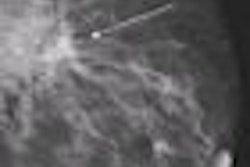Accelerated partial-breast irradiation (APBI) has carved out a niche as a valuable tool in treating low-risk patients with early-stage breast cancer. But could the technique also have a role in patients at increased risk? Maybe, according to a set of recent clinical studies.
APBI using breast brachytherapy devices offers the convenience of reducing the typical course of breast radiation therapy from six to seven weeks of daily treatment to just five consecutive days. Most guidelines restrict the use of APBI to patients with very low risk early-stage breast cancer, but long-term outcomes and effectiveness compared to whole-breast radiation therapy remain unknown.
That could change, however, based on promising early results of trials presented at both the San Antonio Breast Cancer Symposium held earlier this month and the annual meeting of the American Society for Radiation Oncology (ASTRO) held in November in Chicago. The studies provide guardedly optimistic statistics, even for higher-risk early-stage breast cancer patients whom ASTRO guidelines do not recommend as suitable for this treatment outside a clinical trial.
MammoSite five-year update
At the ASTRO meeting, attendees heard results from the American Society of Breast Surgeons MammoSite Breast Brachytherapy Registry Trial, which has reached the five-year outcomes mark. Data indicate that treatment efficacy and cosmesis of 1,440 patients who received treatment with the MammoSite balloon catheter (Hologic, Bedford, MA) are similar to results in patients who received whole-breast radiation with respect to ipsilateral breast tumor recurrence rates.
The patient cohort represents 194 cases of ductal carcinoma in situ (DCIS) and 1,255 cases of invasive breast cancer. As of March 2009, 22% of the 1,449 total cases have been followed for five years and 48% of the cases for at least four years.
Dr. Frank Vicini, a radiation oncologist at William Beaumont Hospital in Royal Oak, MI, and a co-principal investigator of the clinical trial, told ASTRO attendees that 38 cases (2.6%) of ipsilateral breast tumor recurrence had been reported, for a five-year actuarial rate of 3.84%.
Thirty-two (84%) were invasive ipsilateral breast tumor recurrences and six (16%) were DCIS. Fifteen were categorized as recurrences of the index lesion and the remainder as "elsewhere failures." Neither patient age, margins, tumor size, nor positive nodes were statistically associated with the recurrences.
Nine patients developed an axillary failure -- 0.6% of the total, the same percentage reported in 2008. Cosmetic results classified as good-to-excellent also remain high. Rates were 87.8% at five years, 90.6% at four years, and 93.2% at three years.
"These are excellent results and compare very favorably to results obtained with standard six-week radiation," Vicini said. "The significance is that this clinical trial is following the outcomes of the largest group of patients treated with modern partial-breast irradiation."
In all, 176 patients met the classification of being unsuitable to receive APBI treatment outside a clinical trial, based on the clinical guidelines published by ASTRO in July 2009. At five years, the ipsilateral breast tumor recurrence rate for this group was 5.28%, Vicini reported.
He added that the results support enrollment of patients with one or more factors placing them at slightly higher risk in the Radiation Therapy Oncology Group (RTOG) 0413 National Surgical Adjuvant Breast and Bowel Project B-39 randomized trial.
The primary aim of the RTOG 0413 trial is to determine whether partial-breast irradiation limited to the region of the tumor bed following lumpectomy provides equivalent local tumor control in the breast compared to conventional whole-breast irradiation in the local management of early-stage breast cancer. A total of 4,300 women are currently being enrolled and randomized to receive either of the following:
- Whole-breast irradiation of 50 or 50.4 Gy with an optional boost to 60.0-66.6 Gy
- Partial-breast irradiation, delivered with a MammoSite balloon catheter, multicatheter brachytherapy devices, or 3D conformal beam radiation therapy
RTOG 0413 will compare overall survival, recurrence-free survival, and distant disease-free survival between women receiving partial-breast irradiation and women receiving whole-breast radiation therapy. Quality of life related to cosmesis, fatigue, treatment-related symptoms, and perceived convenience of care will be analyzed, as well as acute and late toxicities.
Vicini expressed his concern that patients with one of the risk factors specified in the ASTRO guidelines were not being enrolled due to possible misunderstandings by radiation oncologists. He emphasized that the category of "unsuitable" meant that caution in the use of APBI treatment with these patients should be undertaken, not that they should unilaterally be excluded from this treatment.
"Let's put these women in the phase III trial, so we can find out the answers," he stressed.
However, session moderator Dr. Barbara Fowble, a radiation oncologist at the University of California, San Francisco Medical Center, partially disagreed. She questioned the appropriateness of offering APBI treatment to women younger than 50 years of age.
Outcomes of 'unsuitable' patients
Meanwhile, a presentation at this month's San Antonio Breast Cancer Symposium examined the use of APBI in higher-risk patients with early-stage breast cancer. Researchers from the University of Wisconsin School of Medicine and Public Health in Madison presented their study that examined the outcomes of all patients who received brachytherapy-based APBI at their cancer center between February 2001 and June 2006.
A total of 322 consecutive patients, 107 of whom were classified as "unsuitable" by the ASTRO APBI clinical guidelines, had received brachytherapy-based APBI treatment. The patients received 32 or 34 Gy in eight to 10 fractions using multicatheter (93.5%) or MammoSite balloon (6.5%) brachytherapy.
Eighty (74.7%) of the unsuitable patients were younger than 50. Nineteen patients (17.8%) had one or more positive nodes, 20 patients had extensive lymph vascular space invasion, three patients had tumors larger than 3 cm, and two patients had multifocal disease. Almost 16% of the patients had multiple unsuitable factors.
Eight women in this subgroup were lost to follow-up, but for the remainder, the median follow-up was 60 months, according to third-year radiation oncology resident Dr. Derek McHaffie.
Six patients had ipsilateral breast tumor recurrences, three of whom had concurrent distant relapse. The five-year actuarial rate is 6.6%. Two isolated axillary nodal failures were observed, with a five-year actuarial locoregional control rate of 91.3%. These were identified 10 to 41 months following APBI treatment.
No patient younger than 50 without adverse histopathologic features developed a locoregional recurrence. However, locoregional recurrences were observed in two of 19 node-positive patients, three of 20 patients with lymph vascular space invasion, and one of the two patients with multifocal disease.
Overall, the locoregional recurrence rate for this higher-risk group was 12.3%.
Although this represented an analysis of a small group of patients, the research team noted that the absence of local failures among women younger than 50 who otherwise met the profile of being suitable suggests that they may be appropriate candidates for APBI treatment.
MammoSite and DCIS patients
Finally, another presentation at the San Antonio Breast Cancer Symposium reported encouraging results in a three-year follow-up of outcomes of 100 patients diagnosed with DCIS in a phase II trial. These patients received breast brachytherapy treatment at 12 cancer centers following a lumpectomy, and the study's results are identical to outcomes reported at the San Antonio Breast Cancer Symposium in 2007.
This patient cohort has had four noninvasive ipsilateral recurrences, one of which was outside the region of the original tumor category, according to principal investigator Dr. Oscar Streeter Jr., a radiation oncologist at Howard University Hospital in Washington, DC.
Eligible patients were required to be 45 years of age or older, have unicentric pure DCIS and negative axillary nodes, a tumor measuring 5 cm or less in its greatest dimension, and a lumpectomy negative margin of 1 mm or more.
The mean age of the patients was 60.8 years, with 84% postmenopausal and 5% perimenopausal.
The women received a dose of 34 Gy delivered in 10 fractions over five days between May 2003 and January 2006 at 12 cancer centers in the U.S. Fifty-two of the women also were prescribed endocrine therapy.
Good-to-excellent cosmesis outcomes have also remained consistent, according to the researchers. Ninety-four percent of the patients had good-to-excellent cosmesis, and 6% had fair cosmesis with a follow-up time of at least three months. This represented an increase of 1% since 2007 in patients who only had fair cosmesis.
The infection rate remained constant at 6%, with seven patients developing breast infections and two patients developing cellulitis.
By Cynthia E. Keen
AuntMinnie.com staff writer
December 22, 2009
Related Reading
ASTRO publishes APBI guidelines for early-stage breast cancer, July 16, 2009
Effectiveness of APBI breast cancer treatment is age-neutral, study suggests, April 20, 2009
Study: APBI compares favorably to standard RT, October 1, 2008
Copyright © 2009 AuntMinnie.com



















